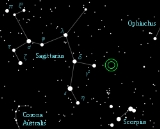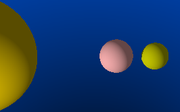
OGLE-2006-BLG-109L
Encyclopedia
OGLE-2006-BLG-109L (where 'L' stands for lens) is a dim magnitude
17 unclassified
galactic bulge star
approximately 4,920 light-year
s away in the constellation
of Sagittarius
.
s were discovered around the star using gravitational microlensing
. The two planets are at a distance from their star that make them suspected analogs of Jupiter
and Saturn
. The star is surrounded by a planetary system
The star is surrounded by a planetary system
consisting of at least two planets: b
with a mass of 0.727 of Jupiter
and c
with the mass of approximately 0.271 of Jupiter
. Their mass ratios, distance ratios, and equilibrium temperatures are similar to those of Jupiter and Saturn
in the solar system
as well as the 47 UMa system.
Both planets were discovered simultaneously by gravitational microlensing
in a common effort by the Optical Gravitational Lensing Experiment
, microFUN, MOA
, PLANET
and RoboNet
collaborations, as announced on 14 February 2008.
Apparent magnitude
The apparent magnitude of a celestial body is a measure of its brightness as seen by an observer on Earth, adjusted to the value it would have in the absence of the atmosphere...
17 unclassified
Stellar classification
In astronomy, stellar classification is a classification of stars based on their spectral characteristics. The spectral class of a star is a designated class of a star describing the ionization of its chromosphere, what atomic excitations are most prominent in the light, giving an objective measure...
galactic bulge star
Star
A star is a massive, luminous sphere of plasma held together by gravity. At the end of its lifetime, a star can also contain a proportion of degenerate matter. The nearest star to Earth is the Sun, which is the source of most of the energy on Earth...
approximately 4,920 light-year
Light-year
A light-year, also light year or lightyear is a unit of length, equal to just under 10 trillion kilometres...
s away in the constellation
Constellation
In modern astronomy, a constellation is an internationally defined area of the celestial sphere. These areas are grouped around asterisms, patterns formed by prominent stars within apparent proximity to one another on Earth's night sky....
of Sagittarius
Sagittarius (constellation)
Sagittarius is a constellation of the zodiac, the one containing the galactic center. Its name is Latin for the archer, and its symbol is , a stylized arrow. Sagittarius is commonly represented as a centaur drawing a bow...
.
Planetary system
In 2008, two extrasolar planetExtrasolar planet
An extrasolar planet, or exoplanet, is a planet outside the Solar System. A total of such planets have been identified as of . It is now known that a substantial fraction of stars have planets, including perhaps half of all Sun-like stars...
s were discovered around the star using gravitational microlensing
Gravitational microlensing
Gravitational microlensing is an astronomical phenomenon due to the gravitational lens effect. It can be used to detect objects ranging from the mass of a planet to the mass of a star, regardless of the light they emit. Typically, astronomers can only detect bright objects that emit lots of light ...
. The two planets are at a distance from their star that make them suspected analogs of Jupiter
Jupiter
Jupiter is the fifth planet from the Sun and the largest planet within the Solar System. It is a gas giant with mass one-thousandth that of the Sun but is two and a half times the mass of all the other planets in our Solar System combined. Jupiter is classified as a gas giant along with Saturn,...
and Saturn
Saturn
Saturn is the sixth planet from the Sun and the second largest planet in the Solar System, after Jupiter. Saturn is named after the Roman god Saturn, equated to the Greek Cronus , the Babylonian Ninurta and the Hindu Shani. Saturn's astronomical symbol represents the Roman god's sickle.Saturn,...
.

Planetary system
A planetary system consists of the various non-stellar objects orbiting a star such as planets, dwarf planets , asteroids, meteoroids, comets, and cosmic dust...
consisting of at least two planets: b
OGLE-2006-BLG-109L b
OGLE-2006-BLG-109Lb is an extrasolar planet approximately 4,920 light-years away in the constellation of Sagittarius. The planet was detected orbiting the star OGLE-2006-BLG-109L in 2008 by a research team using Microlensing.- See also :...
with a mass of 0.727 of Jupiter
Jupiter
Jupiter is the fifth planet from the Sun and the largest planet within the Solar System. It is a gas giant with mass one-thousandth that of the Sun but is two and a half times the mass of all the other planets in our Solar System combined. Jupiter is classified as a gas giant along with Saturn,...
and c
OGLE-2006-BLG-109L c
OGLE-2006-BLG-109Lc is an extrasolar planet approximately 4,920 light-years away in the constellation of Sagittarius. The planet was detected orbiting the star OGLE-2006-BLG-109L in 2008 by a research team using Microlensing...
with the mass of approximately 0.271 of Jupiter
Jupiter
Jupiter is the fifth planet from the Sun and the largest planet within the Solar System. It is a gas giant with mass one-thousandth that of the Sun but is two and a half times the mass of all the other planets in our Solar System combined. Jupiter is classified as a gas giant along with Saturn,...
. Their mass ratios, distance ratios, and equilibrium temperatures are similar to those of Jupiter and Saturn
Saturn
Saturn is the sixth planet from the Sun and the second largest planet in the Solar System, after Jupiter. Saturn is named after the Roman god Saturn, equated to the Greek Cronus , the Babylonian Ninurta and the Hindu Shani. Saturn's astronomical symbol represents the Roman god's sickle.Saturn,...
in the solar system
Solar System
The Solar System consists of the Sun and the astronomical objects gravitationally bound in orbit around it, all of which formed from the collapse of a giant molecular cloud approximately 4.6 billion years ago. The vast majority of the system's mass is in the Sun...
as well as the 47 UMa system.
Both planets were discovered simultaneously by gravitational microlensing
Gravitational microlensing
Gravitational microlensing is an astronomical phenomenon due to the gravitational lens effect. It can be used to detect objects ranging from the mass of a planet to the mass of a star, regardless of the light they emit. Typically, astronomers can only detect bright objects that emit lots of light ...
in a common effort by the Optical Gravitational Lensing Experiment
Optical Gravitational Lensing Experiment
The Optical Gravitational Lensing Experiment or OGLE is a Polish astronomical project based at the University of Warsaw that is chiefly concerned with discovering dark matter using the microlensing technique. Since the project began in 1992, it has discovered several extrasolar planets as a side...
, microFUN, MOA
Microlensing Observations in Astrophysics
Microlensing Observations in Astrophysics is a collaborative project between researchers in New Zealand and Japan, led by Professor Yasushi Muraki of Nagoya University. They use microlensing to observe dark matter, extra-solar planets, and stellar atmospheres from the Southern Hemisphere...
, PLANET
Probing Lensing Anomalies Network
The Probing Lensing Anomalies NETwork collaboration coordinates a network of telescopes to rapidly sample photometric measurements of the magnification of stars in the galactic bulge undergoing gravitational microlensing by intervening foreground stars...
and RoboNet
RoboNet
RoboNet-1.0 was a prototype global network of UK-built 2-metre robotic telescopes, the largest of their kind in the world, comprising the Liverpool Telescope on La Palma , the Faulkes Telescope North on Maui , and the Faulkes Telescope South in Australia, managed by a consortium of ten UK...
collaborations, as announced on 14 February 2008.

